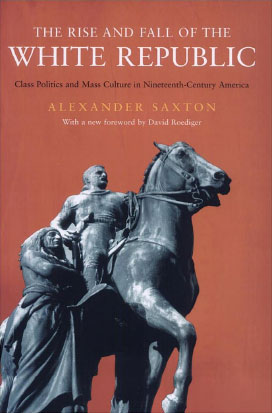The Rise and Fall of the White Republic:
Class Politics and Mass Culture in Nineteenth-Century America
 Is racism a blot on the American democratic tradition? Or, as Alexander Saxton argues, has racial discrimination always been integral
to it? In the nineteenth century the United States was transformed into an industrialized mass democratic society. But central to
this economic growth and the territorial expansion which accompanied it were slave labor in the South and the expropriation of Indian
lands in the West.
Is racism a blot on the American democratic tradition? Or, as Alexander Saxton argues, has racial discrimination always been integral
to it? In the nineteenth century the United States was transformed into an industrialized mass democratic society. But central to
this economic growth and the territorial expansion which accompanied it were slave labor in the South and the expropriation of Indian
lands in the West.
In this meticulous historical study, Saxton asks why white racism remained an ideological force in America long after the need to
justify slavery and Western conquest had disappeared. He shows how the notion of white racial superiority continued to meet the needs
of the various class coalitions that ruled the nation, at the same time as a creed of liberty and equality became dominant. And he
explores the processes of idelogical revision that made possible these seeminingly contradictory transformations.
Examining images of race at a popular level—from blackface minstrelsy to the construction of the Western hero; from grassroots
political culture to dime novels—as well as the philosophical construction of the political elite, The Rise and Fall of the
White Republic is a powerful and comprehensive account of the idelogical forces at work in the formation of modern America.
"No other book offers us such a richly detailed and elegantly written illumination of the relationship between race and the labyrinth
of American party politics in the nineteenth century."
—Ron Takaki, Prof. of Ethnic Studies, UC Berkeley
"A penetrating analysis of how popular and literary culture spread the gospel of white racial superiority. This book is a gem of
historical craftsmanship."
—Gary Nash, Prof. of History, UCLA
"[Saxton] sees little difficulty in understanding how the theory of white superiority arose out of the need to vindicate a class of
people that grew rich from the slave trade, slavery, and the expropriation of land from nonwhite populations; the more formidable
problem is to explain why nonslaveholding whites acquiesed either in planter dominance or its justifications. The Rise and
Fall, then is a study of the role of white supremacy in legitimating the changing class coalitions that ruled the US in the
nineteenth century."
—Noel Ignatin, in How the Irish Became White
Alexander Saxton, a professor emeritus of history at the University of California, Los Angeles, is also the author of The
Indispenasble Enemy: Labor and Anti-Chinese Movement in California as well as several novels. He spent nearly twenty years
as a merchant seaman and carpenter before launching a distinguished academic career.
London and New York: Verso Books, 2003.
ISBN-10: 1859844677
ISBN-13: 978-1859844670